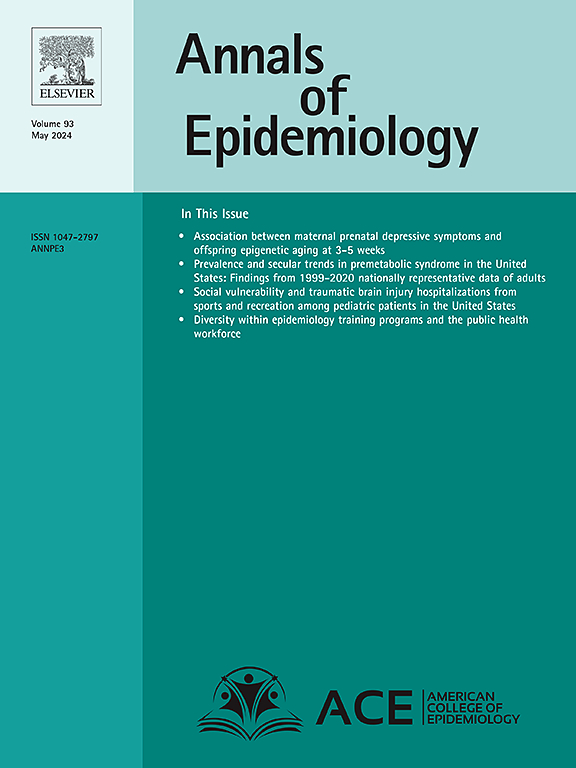1999-2022年非西班牙裔美洲印第安人/阿拉斯加土著人药物过量死亡率
IF 3.3
3区 医学
Q1 PUBLIC, ENVIRONMENTAL & OCCUPATIONAL HEALTH
引用次数: 0
摘要
目的研究非西班牙裔美国印第安人/阿拉斯加原住民(AIAN)与白人相比药物过量死亡的流行病学趋势。方法从CDC WONDER数据库中获取数据,分析1999-2022年美国亚裔和白人每10万人中药物过量死亡率。死亡率进一步按死亡方式、性别、年龄、城市化、普查地区、州和特定药物类型分层。结果1999-2022年,AIAN个体药物过量死亡率从3.17(95 % CI, 2.48 ~ 4.00)增加到40.73(95 % CI, 38.19 ~ 43.27),增加了12倍;相比之下,白人的发病率上升了5倍。2022年,甲基苯丙胺是AIAN个体过量死亡率的主要驱动因素,为每10万人31.39(95 % CI, 29.16-33.62),其次是芬太尼,为每10万人22.35(95 % CI, 20.46-24.23)。地域差异显著,AIAN个体在中心大都市地区(53.54 / 10万)和中西部地区(50.31 / 10万)的发病率最高。在我们的分析中,21个州中有20个州的AIAN发病率高于白人(95.2% %)。结论saan个体受到药物过量危机的影响不成比例。需要进一步努力,扩大在亚洲裔人口中获得以减少伤害为内容的、具有文化能力的健康教育、成瘾治疗和社会服务的机会。本文章由计算机程序翻译,如有差异,请以英文原文为准。
Drug overdose mortality rates among non-Hispanic American Indian/Alaska Native individuals, 1999–2022
Purpose
To examine epidemiological trends in drug overdose deaths for non-Hispanic American Indian/Alaska Native (AIAN) individuals compared to White individuals.
Methods
We obtained data from the CDC WONDER database to examine crude drug overdose death rates per 100,000 among AIAN and White individuals from 1999–2022. Rates were further stratified by manner of death, sex, age, urbanization, Census region, state, and specific drug types.
Results
From 1999–2022, drug overdose death rates for AIAN individuals increased from 3.17 (95 % CI, 2.48–4.00) to 40.73 (95 % CI, 38.19–43.27), representing a 12-fold increase; in contrast, rates rose by five-fold for White individuals. In 2022, methamphetamine was the leading driver of overdose death rates for AIAN individuals, at 31.39 (95 % CI, 29.16–33.62) per 100,000, followed by fentanyl, at 22.35 (95 % CI, 20.46–24.23) per 100,000. Geographical variations were notable, with the highest rates for AIAN individuals in large central metropolitan regions (53.54 per 100,000) and the Midwest (50.31 per 100,000). Rates were higher for AIAN than White individuals in 20 of the 21 states (95.2 %) included in our analysis.
Conclusions
AIAN individuals are disproportionately impacted by the overdose crisis. Further efforts are needed to expand access to harm reduction-informed, culturally-competent health education, addiction treatment, and social services in the AIAN population.
求助全文
通过发布文献求助,成功后即可免费获取论文全文。
去求助
来源期刊

Annals of Epidemiology
医学-公共卫生、环境卫生与职业卫生
CiteScore
7.40
自引率
1.80%
发文量
207
审稿时长
59 days
期刊介绍:
The journal emphasizes the application of epidemiologic methods to issues that affect the distribution and determinants of human illness in diverse contexts. Its primary focus is on chronic and acute conditions of diverse etiologies and of major importance to clinical medicine, public health, and health care delivery.
 求助内容:
求助内容: 应助结果提醒方式:
应助结果提醒方式:


